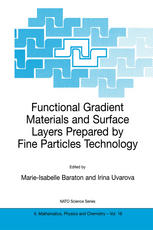

Most ebook files are in PDF format, so you can easily read them using various software such as Foxit Reader or directly on the Google Chrome browser.
Some ebook files are released by publishers in other formats such as .awz, .mobi, .epub, .fb2, etc. You may need to install specific software to read these formats on mobile/PC, such as Calibre.
Please read the tutorial at this link: https://ebookbell.com/faq
We offer FREE conversion to the popular formats you request; however, this may take some time. Therefore, right after payment, please email us, and we will try to provide the service as quickly as possible.
For some exceptional file formats or broken links (if any), please refrain from opening any disputes. Instead, email us first, and we will try to assist within a maximum of 6 hours.
EbookBell Team

4.1
60 reviewsThe NATO Advanced Study Institute on "Functional Gradient Materials and Surface Layers Prepared by Fine Particles Technology" was held in Kiev (Ukraine) on June 18- 28, 2000 where more than 90 participants, ranging from Ph.D. students to experienced senior scientists, met and exchanged ideas. This meeting was aimed at stimulating the research work across traditional disciplinary lines by bringing together scientists from diverse research areas related to functional gradient materials and surface layers. It also intended to give opportunities for initiating collaborative works between scientists from NATO and Partner countries and to trigger fruitful and exciting discussions between experienced and young researchers. In this respect, this NATO-ASI has been quite successful. The term of functional gradient materials which originates from Japan in the 1980's describes a class of engineering materials with spatially inhomogeneous microstructures and properties (MRS Bulletin, 1995,20, N°l). These materials can be successfully utilized in various applications like electronic devices, optical films, anti wear and anti-corrosion coatings, thermal barrier coatings, biomaterials, to name only a few. Although these functional gradient materials are not fundamentally new, the use of nanoparticles in their fabrication and in surface layers as well has greatly improved their performances to meet challenging requirements for industrial applications.